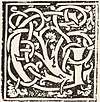VI.
HANS HOLBEIN.
 Fig. 50.—From the "Epistole di San Hieronymo." Ferrara, 1497.ERMANY produced one artist who freed himself from the limitations of taste and interest which the place of his birth imposed upon him, and took rank with the great masters who seem to belong rather to the race than to their native country. Hans Holbein was neither German nor Italian, neither classical nor mediæval. The ideal of his art was not determined by the culture of any single school, at home or abroad; far less was it a jarring compromise between the aims and methods of different schools; it grew out of a faithful study of all, and in it were rationally blended the elements which were right in each. In style, theme, and spirit he advanced so far beyond his contemporaries that he became the first modern artist—the first to clear his vision from the deceptions of religious enthusiasm, and to subdue in himself the lawlessness of the romantic spirit; the first to perceive that only the purely human interest gives lasting significance to any artistic work, and to depict humanity simply for its own sake; the first to express his
Fig. 50.—From the "Epistole di San Hieronymo." Ferrara, 1497.ERMANY produced one artist who freed himself from the limitations of taste and interest which the place of his birth imposed upon him, and took rank with the great masters who seem to belong rather to the race than to their native country. Hans Holbein was neither German nor Italian, neither classical nor mediæval. The ideal of his art was not determined by the culture of any single school, at home or abroad; far less was it a jarring compromise between the aims and methods of different schools; it grew out of a faithful study of all, and in it were rationally blended the elements which were right in each. In style, theme, and spirit he advanced so far beyond his contemporaries that he became the first modern artist—the first to clear his vision from the deceptions of religious enthusiasm, and to subdue in himself the lawlessness of the romantic spirit; the first to perceive that only the purely human interest gives lasting significance to any artistic work, and to depict humanity simply for its own sake; the first to express his
